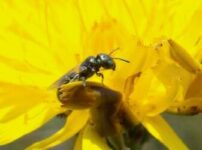
Bees in the fall garden
Bees in the fall garden
Russel Barsh, Director, KWIAHT and Journal contributor
Take a closer look at what seems to be a small black ant in your daisies or dandelions: it is most likely a Ceratina, one of the smallest, least recognized of our wild native bees; and one of the most valuable to island gardeners.
Ceratinas emerge in early spring and are often still busy collecting pollen in September, one of the last bees to be seen each year. There are about 300 Ceratina species worldwide, but only two of them have been identified in the islands: Ceratina nanula and Ceratina acantha. Both of them are small, dark, and metallic, with tiny yellow nose-like patches on their faces. They are not only widespread and abundant in the San Juan Islands, but found throughout western North America, where they have been observed feeding on more than 50 different plant species as varied as cactus, willows, and gumweed.
Ceratinas are often called “small carpenter bees,” but unlike the “large carpenter bees” (Xylocopa) of southern Oregon and California, they do not chew into wood to form tunnel nests. Instead, Ceratinas hollow out the relatively soft pith inside the stems of shrubs. In our area, Ceratina nests are most likely to be found in blackberries, thimbleberries, salmonberries, and other wild and garden Rubus species; that is to say, the “cane fruits” that thrive in our climate. With their long foraging season, many Ceratina queens will raise a spring brood to adulthood, then start a new nest in late summer and raise a second brood.
But Ceratinas are more than abundant wild generalist bees that nest in our seemingly endless Rubus thickets, and often raise two broods each year. Females not only store provisions for their offspring like other bees; they also remain with, tend and feed their developing offspring through the winter. In the spring, the old queen and her now-adult offspring emerge together, and all seek fresh berry canes or stems to excavate new nests.
Two females may build a nest together and share responsibilities, with one ordinarily staying behind with the brood while the other forages. In other Ceratina species, the founding queen hatches an egg that develops quickly into a single small female worker, who forages for pollen and nectar as a kind of deputy or assistant. All the other eggs slowly develop into full-sized reproductive adult bees.
Male Ceratinas also over-winter, but ordinarily alone, wherever they can find old nests or boreholes to occupy. In some species, however, males spend their summers loitering around the nests of females and guard them from predators and parasitoids.
Multiple females may share a nest and over-winter together with their developing broods. All in all, the Ceratinas seem just a few steps removed from the kind of social structure exemplified by bumblebees. And Ceratinas are relatively long-lived in comparison with other bees. One recent European study found that most female and male Ceratinas survived their first winter and many survived a second winter, living to see a third summer.
What can gardeners do to attract Ceratinas to nest, forage and pollinate? You do not need a bee hotel, and you certainly do not need to buy bees. Ceratinas like to dig nests into the freshly cut ends of stems. You can invite Ceratinas to nest by cutting back last year’s fruited Rubus stems as early as these bees are active in spring—March or April—leaving the freshly-cut stalks about 18 inches high. In other words, you can schedule and manage your annual pruning of raspberries and other cane fruits in ways that have the added advantage of building your garden’s own Ceratina pollinator community!
It should be noted that Ceratinas are not “cane borers” that damage or kill new growth in berries and roses. Cane borers are nearly all beetles; a few are actually moth caterpillars. None of them are bees. A cane borer eats the living tissue inside a growing steam while, by comparison, Ceratinas excavate the pith from old second-year stems, and their nests only take up a few inches. You probably already have at least a few Ceratinas in your garden and probably never noticed their discreet, hidden nests.



